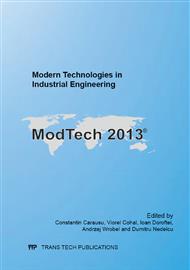[1]
W. Banaś, A. Dymarek, T. Dzitkowski, G. Gołda, K Herbuś, G. Kost, P. Ociepka, Concept of a simulator for teaching how to drive a car for people with disabilities, 18th International Scientific and Engineering Conference - Machine-Building and Technosphere on the Border of the XXI Century. 4 (2011).
DOI: 10.4028/www.scientific.net/ssp.198.59
Google Scholar
[2]
A. Dymarek, T. Dzitkowski, K. Herbuś, G. Kost, P. Ociepka, Determination of acceleration of a car's passenger as the base for designing of a simulator for how to drive a car for disabled people, Lecture Notes in Information Technology. 15 (2012).
DOI: 10.4028/www.scientific.net/ssp.198.59
Google Scholar
[3]
A Dymarek, T. Dzitkowski, K. Herbuś, G. Kost, P. Ociepka, The simulator for teaching how to drive a car for people with disabilities, Solid State Phenomena. 198 (2013) 59-66.
DOI: 10.4028/www.scientific.net/ssp.198.59
Google Scholar
[4]
D. Stewart, A platform with six degrees of freedom, Proceedings of the Institution of Mechanical Engineers, Part 1. 180/15 (1965) 371-386.
DOI: 10.1243/pime_proc_1965_180_029_02
Google Scholar
[5]
H. -L. Tseng, I-K. Fong, Implementation of a driving simulator based on a Stewart platform and computer graphics technologies, Asian Journal of Control. 2/2 (2000) 88-100.
DOI: 10.1111/j.1934-6093.2000.tb00148.x
Google Scholar


